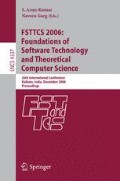Abstract
A center-transversal line for two finite point sets in ℝ3 is a line with the property that any closed halfspace that contains it also contains at least one third of each point set. It is known that a center-transversal line always exists [12],[24] but the best known algorithm for finding such a line takes roughly n 12 time. We propose an algorithm that finds a center-transversal line in \({\it O}({\it n}^{\rm 1+{\it \epsilon}}{\it \kappa}^{\rm 2}({\it n}))\) worst-case time, for any \({\it \epsilon}>\)0, where \({\it \kappa}({\it n})\) is the maximum complexity of a single level in an arrangement of n planes in ℝ3. With the current best upper bound \({\it \kappa}\)(n)=O(n 5/2) of [21], the running time is \({\it O}({\it n}^{\rm 6+{\it \epsilon}})\), for any \({\it \epsilon} > 0\). We also show that the problem of deciding whether there is a center-transversal line parallel to a given direction u can be solved in O(nlogn) expected time. Finally, we We also extend the concept of center-transversal line to that of bichromatic depth of lines in space, and give an algorithm that computes a deepest line exactly in time \({\it O}({\it n}^{\rm 1+{\it \epsilon}}{\it \kappa}^{\rm 2}({\it n}))\), and a linear-time approximation algorithm that computes, for any specified \({\it \delta}>0\), a line whose depth is at least \(1-{\it \delta}\) times the maximum depth.
P.A. was supported by NSF under grants CCR-00-86013 EIA-98-70724, EIA-99-72879, EIA-01-31905, and CCR-02-04118. S.C. was partially supported by the European Community Sixth Framework Programme under a Marie Curie Intra-European Fellowship, and by the Slovenian Research Agency, project J1-7218-0101. J.A.S. was partially supported by grant TIN2004-08065-C02-02 of the Spanish Ministry of Education and Science (MEC). M.S. was partially supported by NSF Grants CCR-00-98246 and CCF-05-14079, by grant 155/05 of the Israel Science Fund, and by the Hermann Minkowski–MINERVA Center for Geometry at Tel Aviv University. P.A. and M.S. were also supported by a joint grant from the U.S.-Israeli Binational Science Foundation.
Access this chapter
Tax calculation will be finalised at checkout
Purchases are for personal use only
Preview
Unable to display preview. Download preview PDF.
References
Agarwal, P.K.: Ray shooting and other applications of spanning trees with low stabbing number. SIAM J. Comput. 21, 540–570 (1992)
Agarwal, P.K., Matoušek, J.: Dynamic half-space range reporting and its applications. Algorithmica 13, 325–345 (1995)
Agarwal, P.K., Sharir, M.: Arrangements and their applications. In: Sack, J.-R., Urrutia, J. (eds.) Handbook of Computational Geometry, pp. 49–119. Elsevier Science Publishers B.V., North-Holland (2000)
Agarwal, P.K., Sharir, M., Welzl, E.: Algorithms for center and Tverberg points. In: Proc. 20th Annu. ACM Sympos. Comput. Geom., pp. 61–67 (2004); Also to appear in ACM Trans. Algorithms
Bern, M., Eppstein, D.: Multivariate regression depth. Discrete Comput. Geom. 28(1), 1–17 (2002)
Chan, T.M.: An optimal randomized algorithm for maximum Tukey depth. In: Proc. 15th Annu. ACM-SIAM Sympos. Discrete Algorithms, pp. 430–436 (2004)
Chazelle, B.: Cutting hyperplanes for divide-and-conquer. Discrete Comput. Geom. 9(2), 145–158 (1993)
Chazelle, B.: The Discrepancy Method: Randomness and Complexity. Cambridge University Press, New York (2001)
Chazelle, B., Edelsbrunner, H., Guibas, L., Sharir, M.: Algorithms for bichromatic line segment problems and polyhedral terrains. Algorithmica 11, 116–132 (1994)
Clarkson, K.L., Eppstein, D., Miller, G.L., Sturtivant, C., Teng, S.-H.: Approximating center points with iterated Radon points. In: Proc. 9th Annu. ACM Sympos. Comput. Geom., pp. 91–98 (1993)
Dey, T.K.: Improved bounds on planar k-sets and related problems. Discrete Comput. Geom. 19, 373–382 (1998)
Dol’nikov, V.: A generalization of the sandwich theorem. Mathematical Notes 52, 771–779 (1992)
Halperin, D., Sharir, M.: New bounds for lower envelopes in three dimensions, with applications to visibility in terrains. Discrete Comput. Geom. 12, 313–326 (1994)
Jadhav, S., Mukhopadhyay, A.: Computing a centerpoint of a finite planar set of points in linear time. Discrete Comput. Geom. 12, 291–312 (1994)
Matoušek, J.: Lectures on Discrete Geometry. Springer, Berlin (2002)
Naor, N., Sharir, M.: Computing a point in the center of a point set in three dimensions. In: Proc. 2nd Canad. Conf. Comput. Geom., pp. 10–13 (1990)
Pellegrini, M.: On lines missing polyhedral sets in 3-space. Discrete Comput. Geom. 12, 203–221 (1994)
Pellegrini, M.: Ray shooting and lines in space. In: Goodman, J.E., O’Rourke, J. (eds.) Handbook of Discrete and Computational Geometry, ch. 37, 2nd edn., pp. 839–856. CRC Press LLC, Boca Raton (2004)
Rousseeuw, P., Hubert, M.: Depth in an arrangement of hyperplanes. Discrete Comput. Geom. 22, 167–176 (1999)
Rousseeuw, P., Hubert, M.: Regression depth. J. Amer. Stat. Assoc. 94, 388–402 (1999)
Sharir, M., Smorodinsky, S., Tardos, G.: An improved bound for k-sets in three dimensions. Discrete Comput. Geom. 26, 195–204 (2001)
Sharir, M., Welzl, E.: A combinatorial bound for linear programming and related problems. In: Proc. 9th Annu. Sympos. Theoretical Aspects of Computer Science, pp. 569–579 (1992)
Toth, G.: Point sets with many k-sets. Discrete Comput. Geom. 26(2), 187–194 (2001)
Živaljević, R.T., Vrećica, S.T.: An extension of the ham sandwich theorem. Bull. London Math. Soc. 22, 183–186 (1990)
Author information
Authors and Affiliations
Editor information
Editors and Affiliations
Rights and permissions
Copyright information
© 2006 Springer-Verlag Berlin Heidelberg
About this paper
Cite this paper
Agarwal, P.K., Cabello, S., Sellarès, J.A., Sharir, M. (2006). Computing a Center-Transversal Line. In: Arun-Kumar, S., Garg, N. (eds) FSTTCS 2006: Foundations of Software Technology and Theoretical Computer Science. FSTTCS 2006. Lecture Notes in Computer Science, vol 4337. Springer, Berlin, Heidelberg. https://doi.org/10.1007/11944836_11
Download citation
DOI: https://doi.org/10.1007/11944836_11
Publisher Name: Springer, Berlin, Heidelberg
Print ISBN: 978-3-540-49994-7
Online ISBN: 978-3-540-49995-4
eBook Packages: Computer ScienceComputer Science (R0)

